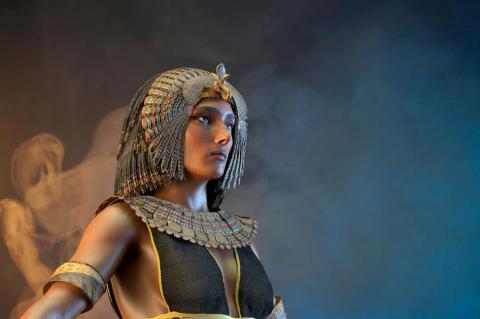Although many people today refer to the wives of ancient Egyptian kings and female Egyptian pharaohs as queens, in ancient Egypt all the people surrounding the king (pharaoh) were referred to by their relationship to him/her. This was not meant to diminish a woman’s role per se, it was simply because all royal titles emphasized the individual’s relationship to the powerful king. The king of Egypt was a demi-god living, temporarily, on earth and charged with maintaining maat (justice/truth/order).
Male kings usually inherited the throne, and their consorts were often members of the royal family who were raised to perform their regal roles. Therefore, we find many instances of brother-sister or half-brother-half-sister unions. While these incestuous marriages are a shock today, to the ancient Egyptians it made perfect sense to ensure that the king’s wives (they had several in the harem with different levels of status), were trained for their responsibilities, were loyal to their husbands and children, and it restricted the number of legal claimants to the throne.
Now that you know the background, discover the stories of a few of the Great Wives of ancient Egyptian kings.
Ankhesenamun (r. 1332-1322 BC, Dynasty 18) Titles: King’s Bodily Daughter, King’s Great Wife
Ankhesenamun, originally named Ankhesenpaaton, was a strong queen like her mother (Nefertiti). Some scholars believe she was married to her father near the end of his reign, and they produced a daughter named Ankhesenpaaton-tasherit (“Ankhesenpaaton the Younger”). When her half-brother (or cousin) Tutankhamun ascended to the throne, Ankhesenpaaton married him and also changed her name. She appears on many of her husband Tutankhamun’s public monuments such as the Luxor temple and several items from his tomb, in which she’s represented as the goddess Maat. She also appears as the goddess Mut in a statue from the Luxor temple.
Ankhesenamun is believed to be the mother of the two stillborn daughters whose remains were discovered in her husband’s tomb. Following the death of Tutankhamun, Ankhesenamun should have been relegated to the harem, but she would not give up her role without a fight. The widowed Ankhesenamun is said to have written the following letter to the Hittite king Suppiluliumas, pleading he help her find a husband: My husband has died. I do not have a son. But, they say, you have many sons. If you would give me one of your sons he would become my husband. I shall never pick out a servant of mine and make him my husband…He will be my husband and King of Egypt.
After she supposedly sent the letter, Ankhesenamun disappears from the records. Her mummy has yet to be found.
Nefertiti (c. 1370-1331 BC, Dynasty 18) Titles: King’s Great Wife, Lady of the Two Lands
Nefertiti may have co-ruled the with her husband, the ‘heretic pharaoh’ Akhenaton. She gave birth to six daughters and was a key part of Akhenaton’s monotheistic sun-worshipping cult of Aten. Nefertiti vanishes from ancient records during the 12th year of Akhenaton’s reign. Some say that is when she died, while others suggest that she may have outlived her husband and ruled alone as a pharaoh for a brief time before handing the throne to King Tutankhamun.
Today, Nefertiti is mostly famous for the bust in her image which was excavated during an archaeological dig in 1912. She is known as one of Egypt's most beautiful rulers and some scholars believe she may have been revered as a fertility goddess in ancient Egypt.
Nefertari (c. 1295-1255 BC, Dynasty 19) Titles: God’s Wife, King’s Wife, Mistress of Upper and Lower Egypt, Lady of the Two Lands
Nefertari was a consort of Ramesses II. She wasn’t a princess but may have been a member of King Ay’s wider family. For at least 20 years she appeared alongside her husband as a beautiful, loyal, but passive wife, probably accompanying him on his military campaigns as well. Few details on her true personality or interests are known, and today Nefertari is mostly remembered thanks to the Lesser Temple at Abu Simbel which celebrates her almost divine role as the consort to the divine king. The temple façade proclaims: ‘Ramesses II has made a temple, excavated in the mountain, of eternal workmanship…for the Chief Queen Nefertari Beloved of Mut…Nefertari…for whom the sun shines.’
This is just an overview of a few ancient Egyptian queens, but are you also curious about ancient Egyptian female pharaohs such as Sobekneferu, Hatshepsut, and Tawosret? Discover their stories in the article ‘Female Pharaohs: 5 Women Who Ruled Ancient Egypt’ available in the November-December 2022 issue of Ancient Origins Magazine. Get it here!
By Alicia McDermott




